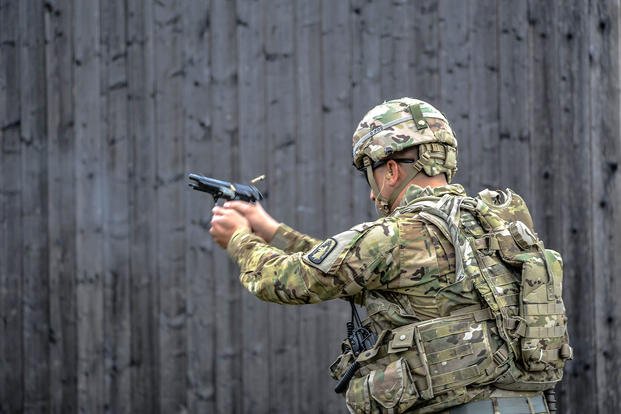Army basic marksmanship training consists of three phases. Training to become a marksman lasts approximately 2-3 weeks and ends with qualification testing, where you must pass with at least a minimum score to graduate. Passing the marksmanship training course will earn you an Army marksmanship badge. You must hit 23 to 29 out of the 40 targets to earn that qualification. If you do a little better (30-35), you qualify for the sharpshooter badge. To get an expert badge, you must hit at least 36 targets.
Phase 1
During the first phase, you learn how to disassemble, clean and reassemble your weapon as well as safe handling procedures. You find out how to load and unload the weapon safely, but you won't fire it during this phase.
Phase 1 of training includes:
- Disassembly and assembly of your weapon
- Identification of parts
- Function check
- Magazine loading and unloading
- Ammunition types and care
- Loading/unloading your weapon
- Correcting malfunctions (SPORTS)
- Front and rear sights adjustments
- Peer coaching
- Eight cycles of function and troubleshooting
Tip: SPORTS is an acronym to remind you of steps to take to clear a weapons malfunction. It stands for Slap, Pull, Observe, Release, Tap and Shoot. During phase 1, you'll also learn and practice the four fundamentals of Army marksmanship:
- Steady position: The steady position teaches you how to grip and handle your weapon correctly during firing and non-firing stances. You also learn how to position your elbow, support the weapon, relax your muscles and feel the natural point of aim.
- Aiming: The aiming fundamental includes correct sight alignment and proper eye focus. You also find out how to establish and maintain a viable sight picture.
- Breath control: In order to hit what you're aiming at, you must know and practice proper breath control. When you fire the weapon, you hold your breath. Breathing while firing will cause the bullet to move up or down, missing your intended target.
- Trigger squeeze: When you fire a weapon in the Army, you do not pull the trigger. Instead, you gently squeeze it. Pulling the trigger results in the weapon shifting left or right so that the bullet misses the intended target.
Phase 2
During phase 2, you get to fire your weapon. You don't have to wear all your combat gear during this phase. The objective is to just get you used to safely and accurately handling your weapon.
Technical Stuff: Until recently, you were required to wear all your combat gear (flak vest, canteen web belt, steel helmet and gas mask carrier) any time you were on the basic training firing range. The Army has eliminated this requirement until after you achieve your basic rifle qualification.
During phase 2, you spend six hours learning how to group your shots and eight hours practicing setting your sights so that you can hit the target. Your instructor then spends six hours giving you feedback about your down-range performance and advice on how to improve your marksmanship ability.
Phase 3
During phase 3 of training, you actually complete the official Army qualification course. You must pass the minimum standards in order to graduate from Army basic combat training.
During this phase, you shoot targets (single and pop-up) from three firing positions:
- Supported prone, in which you stand and fire with your rifle supported by a barricade
- Unsupported prone, where you stand and fire without anything to support your rifle
- Foxhole (replaced the kneeling position), where you kneel and shoot from within a simulated foxhole.
Tip: The foxhole position allows you to support your weapon on the solid ground. In my experience, foxhole is the most stable firing position. In order to qualify, you must hit at least 23 out of 40 pop-up targets at ranges varying from 5 meters to 300 meters (approximately 80 to 327 yards).
From Basic Training for Dummies, copyright © 2011 by Wiley Publishing, Inc., Hoboken, New Jersey. Used by arrangement with John Wiley & Sons, Inc.
Interested in Joining the Military?
We can put you in touch with recruiters from the different military branches. Learn about the benefits of serving your country, paying for school, military career paths, and more: sign up now and hear from a recruiter near you.
















